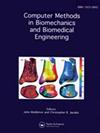在步行模拟中,增加跗中关节僵硬度可降低肱三头肌的代谢成本,但对站立肢体的总代谢成本影响不大。
IF 1.6
4区 医学
Q3 COMPUTER SCIENCE, INTERDISCIPLINARY APPLICATIONS
Computer Methods in Biomechanics and Biomedical Engineering
Pub Date : 2025-08-01
Epub Date: 2024-03-21
DOI:10.1080/10255842.2024.2327635
引用次数: 0
摘要
人们认为足弓有利于提高步态效率。本研究探讨了足弓刚度变化在多大程度上改变了人类步态的代谢能量需求。研究人员使用直接定位法对稳态行走进行了肌肉骨骼计算模拟。在一系列足弓硬度范围内,随着足弓硬度的增加,运输的代谢成本降低了不到1%。足弓硬度的增加提高了推起时肱三头肌的代谢效率,但这些变化几乎完全被其他肌肉群随着足弓硬度的增加而消耗更多能量所抵消。本文章由计算机程序翻译,如有差异,请以英文原文为准。
Increasing midtarsal joint stiffness reduces triceps surae metabolic costs in walking simulations but has little effect on total stance limb metabolic cost.
The human foot's arch is thought to be beneficial for efficient gait. This study addresses the extent to which arch stiffness changes alter the metabolic energy requirements of human gait. Computational musculoskeletal simulations of steady state walking using direct collocation were performed. Across a range of foot arch stiffnesses, the metabolic cost of transport decreased by less than 1% with increasing foot arch stiffness. Increasing arch stiffness increased the metabolic efficiency of the triceps surae during push-off, but these changes were almost entirely offset by other muscle groups consuming more energy with increasing foot arch stiffness.
求助全文
通过发布文献求助,成功后即可免费获取论文全文。
去求助
来源期刊
CiteScore
4.10
自引率
6.20%
发文量
179
审稿时长
4-8 weeks
期刊介绍:
The primary aims of Computer Methods in Biomechanics and Biomedical Engineering are to provide a means of communicating the advances being made in the areas of biomechanics and biomedical engineering and to stimulate interest in the continually emerging computer based technologies which are being applied in these multidisciplinary subjects. Computer Methods in Biomechanics and Biomedical Engineering will also provide a focus for the importance of integrating the disciplines of engineering with medical technology and clinical expertise. Such integration will have a major impact on health care in the future.

 求助内容:
求助内容: 应助结果提醒方式:
应助结果提醒方式:


